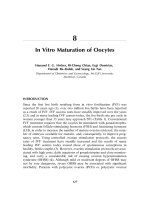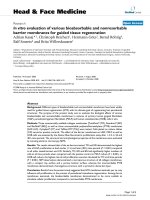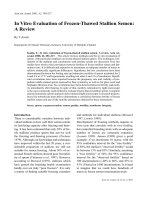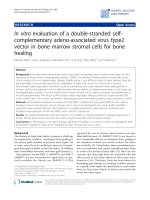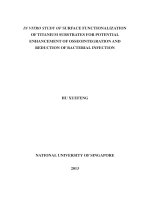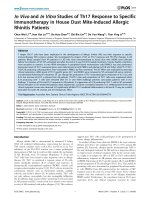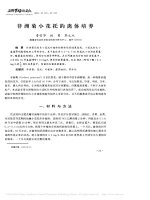In vitro evaluation of fungicides, botanicles and bio-agents against alternaria alternata causal agent of fruit rot of Brinjal
Bạn đang xem bản rút gọn của tài liệu. Xem và tải ngay bản đầy đủ của tài liệu tại đây (304.22 KB, 10 trang )
Int.J.Curr.Microbiol.App.Sci (2017) 6(5): 495-504
International Journal of Current Microbiology and Applied Sciences
ISSN: 2319-7706 Volume 6 Number 5 (2017) pp. 495-504
Journal homepage:
Original Research Article
/>
In vitro Evaluation of Fungicides, Botanicles and Bio-Agents against
Alternaria alternata Causal Agent of Fruit Rot of Brinjal
Sanjeev P. Jakatimath1*, R.K. Mesta1, I.B. Biradar2, Sadanand K. Mushrif3
and P.S. Ajjappalavar4
1
Department of Plant Pathology (University of Horticultural Sciences),
Bagalkot-587104, Karnataka, India
2
Department of Agronomy (University of Horticultural Sciences), Arabavi, Karnataka, India
3
Department of Plant Pathology (University of Horticultural Sciences) Kolar-563101,
Karnataka, India
4
Horticultural Reasearch Station (University of Horticultural Sciences) Devihosur,
Haveri, Karnataka, India
*Corresponding author:
ABSTRACT
Keywords
Alternaria alternate,
Evaluation of
Fungicides,
Antagonism.
Article Info
Accepted:
04 April 2017
Available Online:
10 May 2017
Fruit rot of brinjal caused by Alternaria alternata is an important disease of
eggplant inflicting heavy losses. The present investigation was carried out to
test the efficacy of fungicides, botanicals and bio-agents in vitro. Among
fungicides tested, tebuconazole, difenconazole showed 100 per cent mycelial
inhibition of Alternaria alternata. The results of botanicles tested in vitro
revealed that onion and garlic bulb extract showed highest inhibition of
mycelial growth both @ 5 and 10 per cent concentration. The results of dual
culture technique revealed that fungal bio agents were better than bacterial bioagents in inhibiting the growth of Alternaria alternata. All the strains of
Trichoderma harzianum were found antagonistic to A. alternata, however
stronger antagonism was noticed in case of T. harzianum-21.
Introduction
South Asia accounts for almost 50 per cent of
world brinjal area under cultivation (Harish et
al., 2011). In India, brinjal is mainly grown in
the states like West Bengal, Orissa, Bihar,
Gujarat, Maharastra, Andhra Pradesh,
Karnataka etc. with an area of 7.22 lakh
hectare with a production of 135.58 metric
tonnes and productivity of 19.10 tonnes per
ha (Anon., 2014). It contributes about 12.47
Brinjal or egg plant (Solanum melongena L.)
is an important vegetable crop belongs to the
family solanaceae. It’s one of the most
common, popular and principal vegetable
crops grown in the tropical and sub tropical
areas. It’s a highly productive and usually
finds its place as the poor man’s crop. This
crop is extensively grown in India, Pakistan,
Bangladesh, China and Philippines.
495
Int.J.Curr.Microbiol.App.Sci (2017) 6(5): 495-504
per cent of the total production of vegetables
in India. In Karnataka, brinjal is cultivated
over an area of 15,800 ha with a production of
4002.50 tonnes (Anon., 2014). The crop
suffers from fruit rot during harvesting stage
caused by Alternaria alternata which account
for huge losses to farmer. In India, the disease
Alternaria fruit rot of brinjal was first reported
from IARI, New Delhi. This disease is severe
and apperars regularly, causing heavy losses
in fruit yield. When the environmental
conditions are favourable the fruit rot
incidence can be up to 50% and this can result
serious economic losses, (Smith and Black,
1990).The fruit infection takes place during
fruit formation just some days prior to the
harvest of the crop. This infection becomes
severe at the time of harvesting to marketing.
Some farmers are found using available
fungicides
indiscriminately
and
unscientifically in Bagalkot district of
Karnataka in brinjal fruit rot management.
Therefore, the experiment on efficacy of
fungicides, botanicals and bio-agents for the
management of fruit rot brinjal was taken
under study.
for each concentration. Plates were incubated
at room temperature for seven days and radial
growth was measured when fungus attained
maximum growth in control plates. The
efficacy of the fungicides was expressed as
per cent inhibition of mycelial growth over
control which was calculated by using the
formula of Vincent (1927). To evaluate the
antifungal activity of botanicals fresh samples
were washed in tap water and finally washed
thrice using sterilized distilled water. They
were crushed in a sterilized pestle and mortar
by adding little quantity of alcohol (1:1 w/v)
just enough to moisten the samples so that it
was easy to crush. The extracts were strained
through the two layers of muslin cloth.
Finally, filtrates thus obtained from the leaves
were used as stock solution (Begum and
Bhuiyan, 2006). To study the antifungal
mechanism of plant extracts, poisoned food
technique was followed as suggested by Nene
and Thapliyal (1982). For this, 5 and 10 ml of
stock solutions were mixed with 95 and 90 ml
of sterilized molten potato dextrose agar
medium respectively so as to get 5 and 10 per
cent concentration. The medium was shaken
thoroughly for uniform mixing of plant
extract.
Materials and Methods
The efficacy of 5 systemic fungicides at the
concentration of 0.25, 0.5, 0.75 and 1 per cent
and three non-systemic fungicides at the
concentration of 0.25, 0.5, 0.75 and 1 per cent
was determined. The evaluation of fungicides
was based on the active ingredient
consideration. Required quantity of individual
fungicide was added separately into sterilized
molten PDA so as to get the desired
concentration of the fungicides. Later, 20 ml
of the poisoned media was poured into
sterilized Petri plates. Mycelium discs of five
mm diameter from seven days old culture of
the fungus were cut out by sterile cork borer
and one such disc was placed at the centre of
each plate. PDA without any fungicide served
as control. Three replications were maintained
About 20 ml of medium was poured into each
of the 90 mm sterilized petri plates. Each
plate was seeded with 5 mm mycelial discs
aseptically taken from the periphery of 7 days
old culture and incubated at 27±1°C till the
growth of the colony reaches maximum in
control plate. Three replications were
maintained for each treatment. Suitable
control plates were maintained. Mean colony
diameter in each case was recorded. The
efficacy of the botanicals was expressed as
per cent inhibition of mycelial growth over
control which was calculated by using the
formula as given by Vincent (1927).
Bio-agents were evaluated for their efficacy
through dual culture technique. Twenty ml of
496
Int.J.Curr.Microbiol.App.Sci (2017) 6(5): 495-504
sterilized and cooled potato dextrose agar
medium was poured into sterilized Petri
plates. Fungal antagonists were evaluated by
inoculating a pathogen at one side of the Petri
plate and the antagonist at exactly opposite
side of the same plate by leaving about 4 cm
gaps. For this, actively growing cultures were
used. In case of bacterial antagonist
evaluation, two mycelial discs of pathogen
were inoculated at the periphery of the Petri
plate and bacterial antagonist was streaked in
the centre of the same plate. After required
period of incubation i.e., when the growth in
control plate recorded 90 mm in diameter, the
radial growth of the pathogens was measured.
Per cent inhibition over control was worked
out according to the equation given by
Vincent (1927). The different antagonistic
organisms used against brinjal fruit rot
pathogens includes, Trichoderma harzianum
strains T-21, T-28, T-29, T-72, T-p,
Pseudomonas fluorescens and Bacillus
subtilis maintained at biocontrol unit of UHS
Bagalkot.
100.00 per cent inhibition at all the
concentration tested and hence recorded mean
inhibition of 100.00 per cent propiconazole
(91.25) and carbendazim (85.41) were the
next best fungicides when mean per cent
inhibition was considered.With reference to
interaction
between
fungicides
and
concentrations,
difenconazole
and
hexaconazole recorded 100.00 per cent
inhibition at 0.25% concentration while
propiconazole at 0.75% and 1.00 per cent
recorded 100.00 per cent inhibition.
Propiconazole at 0.5% (93.21), carbendazim
at 1.00% (93.00 per cent) and hexaconazole at
1.00% (92.33 per cent) were next in order and
on par with each other. The results are
depicted in the Fig.1
The Table 2 showed that there is a significant
difference between the treatments with
respect to per cent inhibition of radial growth.
At 5 per cent concentration garlic bulb extract
and onion bulb extract both 100% recorded
maximum inhibition followed by kokum fruit
extract (50.36%), clerodendron leaf extract
(50.36%) and lantana leaf extract and
turmeric rhizome extract both (48.14%). The
least inhibition was recorded in neem seed
kernel extract (38.14%). The results are
depicted in the Fig 2.
Where,
I = Per cent inhibition
C = Growth in control
T = Growth in treatment
At 10 per cent concentration highest
inhibition was recorded in garlic and onion
bulb extract (100%) followed by turmeric
rhizome extract (61.62%) which is on par
with clerodendron extract (61.10%). The least
inhibition of 50.73 per cent was observed in
drumstick leaf extract followed by kokum
fruit extract (52.59%).
Results and Discussion
Five systemic and three non-systemic
fungicides were tested at four concentrations
in the laboratory for their efficacy against
Alternaria alternata causing fruit rot of
brinjal as described in 'Material and Methods'.
The results are presented here under.
The antagonistic activity of five strains of
Trichoderma harzianum, Bacillus subtilis and
Pseudomonas fluorescens were assayed
against A. alternata by dual plate technique as
explained in material and methods. The
Table 1 revealed that there is significant
difference between the fungicides tested. The
efficacy was found increased in all the
fungicides when concentration increased.
Difenconazole and tebuconazole recorded
497
Int.J.Curr.Microbiol.App.Sci (2017) 6(5): 495-504
results revealed that, among all the biocontrol
agents
tested,
Trichoderma
harzianum-72 (87.00%) was most effective in
inhibiting the mycelial growth of Alternaria
alternata than all other treatments. T
harzianum-21 (83.00%), T. harzianum-29
(81.32%) and T. harzianum-28 (80.00%) were
next best and the least mycelial inhibition was
observed incase B. subtilis (7.66%) and P.
fluorescens (12.00%) Table 3 and results are
depicted in Fig 3.
mancozeb was found highly effective in
inhibiting the mycelial growth followed by
copper oxychloride and iprodione at 1000,
2000 and 3000 ppm. But in contrary to our
investigation blitox was second least effective
treatment recorded mean inhibition of (68%).
Ghosh et al., (2002) observed that dithane M45 (0.25%) and bavistin (0.1%) were most
effective against mycelial growth and
sporulation of Alternaria alternata in vitro.
To find out possibilities of replacing
fungicides with other eco-friendly products
for management of disease, plant extracts of
garlic, lantana, neem, onion, kokum, turmeric,
drumstick and clerodendron were tested in
vitro against the mycelial growth and
sporulation of Alternaria alternata. In present
investigation garlic and onion bulb extract
were found most effective against mycelial
growth and sporulation of Alternaria
alternata followed by clerodendron leaf
extract, kokum fruit extract, lantana leaf
extract, turmeric rhizome extract and
drumstick leaf extract at 5 and 10 per cent
concentration. Singh and Majumdar (2001)
reported that extract of Allium sativum
showed lowest root rot disease severity
caused by Alternaria alternata followed by
Ocimum sanctum and Zingiber officinale.
Chaudhary et al., (2003) observed that bulb
extract of Allium sativum was highly effective
in inhibiting the growth of Alternaria
alternata causing early blight of potato.
Prasad and Naik (2003) observed that extracts
of garlic and neem were most effective
against leaf blight of tomato caused by
Alternaria solani. Panchal and Patil (2009)
reported that garlic clove extract (10%) was
proved to be best in inhibiting mycelial
growth and sporulation of Alternaria
alternata incitant of fruit rot of tomato
followed by turmeric and neem leaf extract on
the contrary in present investigation neem
was recorded mean inhibition of (56.66). To
circumvent pollution hazards due to un-
In present investigation, all the fungicides
tested showed better inhibition of the mycelial
growth and sporulation of Alternaria
alternata. Difenconazole and tebuconazole
showed maximum inhibition followed by
carbendazim
and
propiconazole.
Difenconazole and tebuconazole recorded 100
per cent inhibition at 0.50 per cent
concentration. No other fungicide recorded
100 per cent inhibition at the same
concentration tested. The highest inhibition
was recorded by difenconazole and
tebuconazole at all concentrations which were
significantly superior to all other fungicides
tested at the same concentration. Among all,
least inhibition of mycelial growth at all
concentrations was observed in captaf which
was least effective in inhibiting mycelial
growth and sporulation of Alternaria
alternata. This variation in fungus sensitivity
is to be expected with the more specific
benzimidazole and oxathiin compounds and is
well documented (Bollen & Fuchs 1970; Snel
et al., 1970; Edgington et al., 1970), Triazole
are known to inhibit the sterol biosynthesis
pathaway in (Nine and Thapliyal ). Simimilar
observations were reported by Kalra and Sohi
(1984) and Singh and Shukla (1984). Mathur
and Shekhawat (1986) who reported that
Blitox-50 and Dithane M-45 were found most
effective against Alternaria solani. Kamble et
al., (2000) studied efficacy of six fungicides
against tomato and brinjal leaf spot caused by
Alternaria alternata and reported that
498
Int.J.Curr.Microbiol.App.Sci (2017) 6(5): 495-504
judicious use of agrochemicals and also to
avoid development of resistance in pathogenic
fungi against commonly used fungicides, use
of plant extracts for the management of plant
disease increased in recent years and proved
to be very effective against plant diseases.
against Alternaria alternata. Trichoderma-21
was found most effective as compared to
other bio control agents followed by
Trichoderma-72, and produced maximum
zone of inhibition. The least inhibition was
recorded in Bacillus subtilis followed by
Pseudomonas fluoroscens. The results are in
accords with Strashnov et al., (1985) who
reported effectiveness of Trichoderma
harzianum against fruit rot of tomato caused
by Alternaria alternata.
In present investigation, the bio-control
agents viz., Trichoderma-21, Trichoderma-28,
Trichoderma-29,
Trichoderma-72,
Trichoderma-P, Pseudomonas fluoroscens
and Bacillus subtilis were tested in vitro
Botanicals used for in vitro evaluation
Sl. No
1
2
3
4
5
6
7
Common name
Clerodendron
Garlic
Kokum
Lantana
Neem
Onion
Turmeric
Botanical name
Clerodendron inermae
Allium sativum
Garcinia indica
Lantana camera
Azadirachta indica
Allium cepa
Curcuma longa
Parts used
Leaves
Cloves
Fruit
Leaves
Kernel
Bulb
Rhizome
Fungicides used in the in vitro study
Sl.
Common name
No.
Systemic fungicides
1
Carbendazim
2
Difenconazole
3
Hexaconazole
4
Propiconazole
5.
Tebuconazole
Chemical name
Trade name
Methyl 1-2-benzimidazole carbomate
Triazole
(RS)-2-(2,4-dichlorophenyl)-1-(1H12,4-triazol-1-yl) hexan-2-ol
1-(2-(2,4
dichlorophenyl)-4-propyl1,3-dioxolan-2yl) mythyl)-1H-1,2,4triazole
1-(4-Chlorophenyl)-4,4-dimethyl-3(1H,1,2,4-triazol-1-ylmethyl)pentan3-ol
Bavistin 50WP
Score 25 EC
Contaf 5 EC
Tilt 25 EC
Folicur 26 EC
Non-systemic fungicides
1
2
3
Captaf
Copper
oxychloride
Chlorothalonil
N(1,12,2,tetrachloroenc-1-2dicorboximide)
Difoltan 25 WP
Copper oxychloride
Blitox 50 WP
2,4,5,6-Tetrachloroisophthalonitrile
Kavach 75 WP
499
Int.J.Curr.Microbiol.App.Sci (2017) 6(5): 495-504
Table.1 In vitro evaluation of different systemic and non systemic
fungicides against Alternaria alternate
Per cent inhibition over control
Sl. No.
Fungicides
1
Captaf (25 WP)
2
Carbendazim (50 WP)
3
Chlorothalonil (75WP)
4
Copper oxychloride (75 WP)
5
Difenconazole (25 EC)
6
Hexaconazole (5 SC)
7
Propiconazole (25 EC)
8
Tebuconazole (26 EC)
Mean
SEm±
CD@1%
CV
Concentration
0.25 (%)
0.5 (%)
43.42
57.56
(41.16)*
(49.41)
78.33
84.00
(62.26)
(66.42)
56.65
67.34
(48.83)
(55.14)
57.00
62.33
(52.14)
(58.48)
100.00
100.00
(89.71)
(89.71)
56.67
73.34
(48.83)
(58.69)
72.00
93.21
(58.05)
(74.68)
100.00
100.00
(89.71)
(89.71)
73.20
81.33
(62.57)
(68.03)
Fungicides
0.25
0.88
Mean
0.75 (%)
1.0 (%)
63.76
79.00
(52.93)
(62.93)
86.00
93.00
(68.32)
(74.68)
73.00
83.00
(58.69)
(65.65)
72.67
82.33
(49.02)
(65.16)
100.00
100.00
(89.71)
(89.71)
76.00
92.33
(60.66)
(73.97)
100.00
100.00
(89.71)
(89.71)
100.00
100.00
(89.71)
(89.71)
84.04
86.75
(71.51)
(73.27)
Concentration
0.23
0.62
1.08
Table.2 In vitro evaluation of botanicals against Alternaria alternate
Sl. No
Common name
1
Clerodendron leaf extract
2
Drumstick leaf extract
3
Garlic bulb extract
4
Kokum fruit extract
5
Lantana leaf extract
6
Neem seed kernel extract
7
Onion bulb extract
8
Turmeric rhizome extract
5%
50.36
(45.21)*
42.96
(40.95)
100.00
(89.71)
50.36
(45.20)
48.14
(43.93)
38.14
(38.13)
100.00
(89.71)
48.14
(43.93)
1.08
3.29
3.1
SEm±
CD@ 1%
CV
500
Per cent inhibition
10%
61.10
(51.41)
50.73
(45.42)
100.00
(89.71)
52.59
(46.48)
60.36
(50.98)
75.18
(60.14)
100.00
(89.71)
61.62
(51.72)
1.04
3.16
2.59
Mean
55.73
(48.31)
46.84
(43.18)
100.00
(89.71)
51.47
(45.84)
54.25
(47.45)
56.66
(49.13)
100.00
(89.71)
54.88
(47.82)
1.06
3.25
2.85
60.91
(51.56)
85.41
(67.92)
70.00
(57.08)
68.58
(56.20)
100.00
(89.71)
74.50
(60.54)
91.25
(78.04)
100.00
(89.71)
81.33
(68.84)
F×C
0.55
1.77
Int.J.Curr.Microbiol.App.Sci (2017) 6(5): 495-504
Table.3 In vitro evaluation of bio-agents against Alternaria alternate
Sl. No
1
2
3
4
5
6
7
Bio-agents
Percent inhibition of mycelial growth
83.00
(65.65)*
80.00
Trichoderma -28
(63.43)
81.33
Trichoderma -29
(64.40)
87.00
Trichoderma -72
(68.87)
61.00
Trichoderma –P
(51.35)
Pseudomonas
12.00
fluorescens
(20.25)
7.66
Bacillus subtilis
(16.02)
0.52
SEm±
CD@ 1%
1.55
CV
1.61
* Figures presented in parantheses are angular transformed values.
Trichoderma-21
Fig.1 In vitro evaluation of different fungicides against Alternaria alternate
501
Int.J.Curr.Microbiol.App.Sci (2017) 6(5): 495-504
Fig.2 Evaluation of different plant extracts on the growth of Alternaria alternata under in vitro
condition
Fig.3 Evaluation of different bio-agents against Alternaria alternata under in vitro conditions
However Babu et al., (2000) reported that
Trichoderma harzianum and Trichoderma
viride were significantly superior in inhibiting
the mycelial growth of Alternaria solani,
causing leaf blight of tomato. However the
findings of our investigation in contrary with
Vadilal and Ebenezer (2006) reported that
maximum inhibition of mycelial growth and
sporulation of Alternaria solani with
biocontrol agents of Bacillus subtilis,
Trichoderma viride and Gliocladium virens.
The antagonism of Trichoderma spp. against
many fungi is mainly due to production of
acetaldehyde compound (Robinson and Park,
1966 and Dennis and Webster, 1971).
Though, the genus Trichoderma comprises a
large number of species some of which act as
biological control agents through one or more
mechanisms. Sharma et al., 2012 reported that
Trichoderma strains exert control against
fungal phytopathogens either indirectly by
competing for nutrients and space, modifying
502
Int.J.Curr.Microbiol.App.Sci (2017) 6(5): 495-504
the environmental condition, promoting plant
growth, plant defensive mechanisms and
antibiosis, or directly by mechanisms such as
mycoparasitism.
Activation
of
each
mechanism implies the production of specific
metabolites, such as plant growth factors,
hydrolytic enzymes, siderophores, antibiotics,
and permeases. Specific strains of fungi in the
genus Trichoderma colonize and penetrate
plant root tissues and initiate a series of
morphological and biochemical changes in
the plant, considered to be part of the plant
defense response, which subsequently leads to
induced systemic resistance. Antibiosis occurs
during interactions with other microorganisms
involving low molecular weight diffusible
volatile and nonvolatile toxic metabolite
compounds or antibiotics like harzianic acid,
alamethicins, tricholin, eptaibols, antibiotics,
6-penthylpyrone, in consideration of all these
factors involving in suppression of pathogen
growth results Trichoderma is an effective bio
control agent. In order to tackle these global
problems, effective alternatives to chemical
control are being investigated and the use of
antagonistic microbes as biocontrol agent
seems to be one of the promising approaches.
With the advent of biocontrol as a potential
approach to Integrated Pest Management
(IPM) in the area of fungi-mediated plant
disease control, the genus Trichoderma has
gained considerable importance.
specificity of the in vitro and in vivo
antifungal
activity
of
benomyl.
Netherlands J. Pl. Patho., 76: 299-312.
Chaudhary, R.F., Patel, R.L., Chaudhari,
S.M., Pandey, S.K. and Singh, B. 2003.
In vitro evaluation of different plant
extracts against Alternaria alternata
causing early blight of potato. J. Indian
Potato. Asso., 30: 141-142.
Dennis, C. and Webster, J. 1971. Antagonistic
properties of species groups of
Trichoderma Production of volatile
antibiotics. Trans. British Mycol. Soci.,
57: 41-48.
Edgington, L.V., Khew, K.L., Barron, G.L.
1970.
Fungitoxic
spectrum
of
benzimidazole
compounds.
Phytopath., 61: 42-46.
Ghosh, C., Pawar, N.B., Kshirsagar, C.R. and
Jadhav, A.C. 2002. Studies on
management of leaf spot caused by
Alternaria alternata on gerbera. J.
Maharastra Agric. Uni., 27:165-167.
Harish, D.K., Agasimani, A.K., Imamsaheb,
S.J. and Patil Satish, S. 2011. Growth
and yield parameters in brinjal as
influenced
by
organic
nutrient
management and plant protection
condition. J. Agric. Sci., 2(2): 221-225.
Kalra, J.S. and Sohi, H.S. 1984 Studies on
post harvest rots of tomato fruits.
Control of Alternaria fruits rot. Indian
J. Mycol. Pl. Path., 15(3): 256-261.
Kamble, P., U. Ramiah, M. and Patil, D.V.
2000. Efficacy of fungicides in
controlling leaf spot disease of tomato
caused by Alternaria alternata (Fr.)
Kessiler. J. Soil Sci. Crops, 10: 36-38.
Mathur, K. and Shekhawat, K.S. 1986.
Chemical control of early blight in
Kharif sown tomato. Indian J. Mycol.
Pl. Path.., 16: 235-236.
Nene, Y.L. and Thapliyal, P.N. 1982.
Fungicides in Plant Diseases control.
Oxford and IBH Publishing Co. Pvt.
Ltd., New Delhi, p. 163.
References
Anonymous. 2014. Indian Horticulture
database, NHB, pp. 131-132.
Babu, S., Seetharman, K., Nandakumar, R.
and Johnson, I. 2000. Variability in
cultural characteristics of tomato leaf
blight pathogen. Pl. Dis. Res., 15: 121.
Begum, F. and Bhuiyan, M.K.A. 2006.
Integrated control of seedling mortality
of lentil caused by Sclerotium rolfsii.
Bangladesh J. Pl. Path., 23: 60-65.
Bollen, G.J. and Fuchs, A. 1970. On the
503
Int.J.Curr.Microbiol.App.Sci (2017) 6(5): 495-504
Nene, Y.L. and Thapliyal, P.N. 1973.
Fungicide in Plant Diseases control, III
edition. Oxford and IBH Publishing Co.
Pvt. Ltd., New Delhi, p. 325. Edgington,
L. V., Khew, K. L., Barron, G. L., 1970,
Fungitoxic spectrum of benzimidazole
com- pounds. Phytopath., 61: 42-46.
Panchal, D.G. and Patil, R.K. 2009. Ecofriendly management of fruit rot of
tomato caused by Alternaria alternata.
J. Mycol. Pl. Path., 39(1): 66-69.
Prasad, Y. and Naik, M.K. 2003. Evaluation
of genotype fungicides and plant
extracts against early blight of tomato
caused by Alternaria solani. Indian J.
Pl. Pro., 30(2): 49-53.
Robinson, P.M. and Park, D. 1966. Volatile
inhibitor of spore germination produced
by Taagi. Trans. British Mycol. Soc.,
49: 639-649.
Sharma, M., Razdan, V.K. and Rajik, M.
2012. In vitro evaluation of fungicides
and biocontrol agents against brinjal
leaf blight and fruit rot pathogen
Phomopsis vexans (sacc. & syd.) Harter.
Bioinfolet., 9(3): 327 – 332.
Singh, J. and Majumdar, V.L. 2001. Efficacy
of plant extract against Alternaria
alternata. The incitant of fruit rot of
pomegranate (Punica granatum L). J.
Mycol. Pl. Path., 31(3): 346-349.
Singh, M. and Shukla, T.N. 1984. Chemical
control of Alternaria leaf spot and fruit
rot of brinjal caused by Alternaria
alternata. Indian J. Mycol. Pl.
Phytopath., 14(1): 81-83.
Smith, B.J. and Black, L.L. 1990.
Morphological, Cultural and Pathogenic
variation among Colletotrichum sp. from
Strawberry. Pl. Dis., 74: 69-76.
Snel, M., Schmeling, V.B. and Edgington,
L.V. 1970. Fungitoxicity and structureactivity relationships of some oxathiin
and thiazole derivatives. Phytopatho.,
60: 1164-1169.
Strashnov, Y., Elad, Y., Sivan, A., Rudich, Y.
and Chot, I. 1985. Control of
Rhizoctonia solani fruit rot of tomatoes
by Trichoderma harzianum Rifai. Crop
Protection, 4: 359-364.
Vincent, J.M. 1927. Nature, 159 p: 850.
Vadilal, S. and Ebenezar, E.G. 2006. Ecofriendly management of leaf blight of
tomato caused by Alternaria alternata.
J. Mycol. Pl. Pathol., 36(1): 79-83.
How to cite this article:
Sanjeev P. Jakatimath, R.K. Mesta, I.B. Biradar, Sadanand K. Mushrif and Ajjappalavar, P.S.
2017. In vitro Evaluation of Fungicides, Botanicles and Bio-Agents against Alternaria
alternata Causal Agent of Fruit Rot of Brinjal. Int.J.Curr.Microbiol.App.Sci. 6(5): 495-504.
doi: />
504
